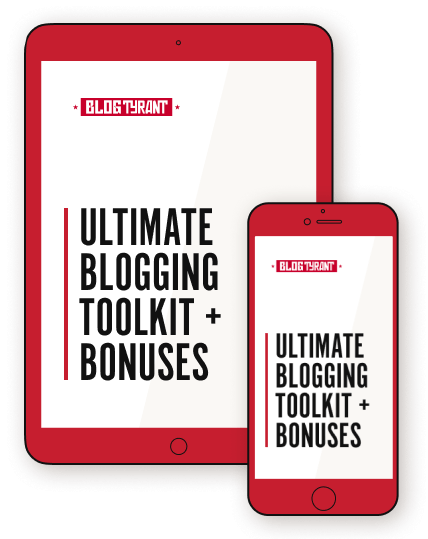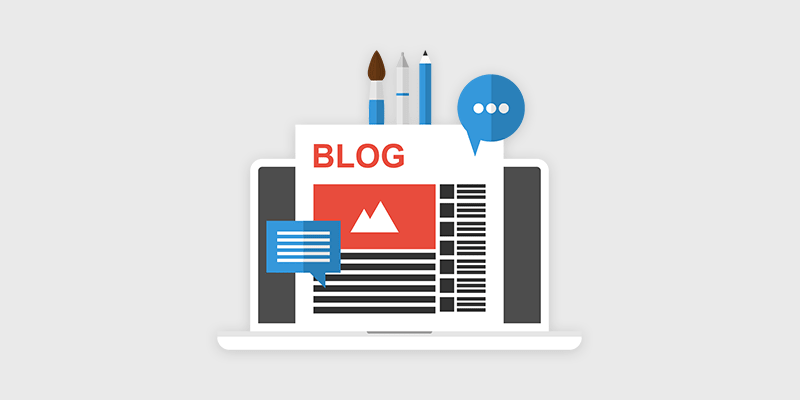
S o, you're wondering how to start a blog, but you have no idea how to go about it?
Don’t worry; I’ve got you covered. I’ve been teaching people how to start a blog and make money online for years.
In this step-by-step guide, I’ll go over everything you need to start your own blog. And the good news – it’s much simpler and faster than you think!
I’ve also put together a checklist for launching a blog so you can check everything off as you go.
In This Guide:
After reading this guide, you’ll be able to set up a blog in 30 minutes or less. You’ll also know exactly what to do next to promote your blog and grow your audience.
Before we begin, I’ll give you the rundown with key takeaways and then cover why you should start a blog.
But if you simply want to dive in – click here to get started with the first step to start a blog.
Key Takeaways On How to Start a Blog
- Starting a blog is simpler and faster than most people think, and it doesn’t require technical expertise.
- Choosing a free blogging platform has limitations and risks, such as a lack of customization and the potential for your blog to be taken down without notice.
- The best way to start a blog is with WordPress.org, which offers flexibility and control but requires hosting and a domain name.
- Picking a blog topic should be based on passion or demand, with a preference for topics that have a large audience interested.
- Creating your blog involves selecting a topic, choosing a blogging platform, setting up WordPress, customizing your blog’s design, and writing your first post.
- To grow your blog and make money, focus on SEO, creating valuable content, engaging with your audience, and exploring monetization options like Google Adsense, affiliate marketing, and creating an online store.
- Essential plugins like All in One SEO, WPForms, and MonsterInsights can enhance your blog’s functionality and user experience.
- Regularly backing up your blog with plugins like UpdraftPlus and ensuring its security with tools like Sucuri are crucial steps.
- To attract readers, produce content that solves their problems, use blogging SEO strategies to increase visibility, and engage with your audience on social media and forums.
- Blogs can make money through various methods, including advertising, affiliate marketing, selling products or services, and sponsored content.
Why Start a Blog?
Whatever your reasons for starting a blog, there are plenty of benefits you might not even realize!
Here are just a few reasons to start a blog:
- Make money online: I’m starting with the best reason first! A blog has the potential to make money every month through various methods. You can earn money through running ads, selling your own products and services, recommending other businesses with affiliate marketing, and more.
- Build an audience: Let’s say that you will launch a product or a book soon, and you want to build some buzz before the launch. A blog is the best way to spread the word.
- Attract targeted leads: Maybe you already have a business and want to generate leads and get more customers. Publishing fresh content to a blog is the best way to do that.
- Express yourself as a writer: Blogging improves your writing skills. You can share your stories, encourage people, and build a community through your blogs.
Can I Start a Blog for Free?
The short answer is yes, you can start a blog for free.
However, as tempting as it may sound, choosing the free option to start blogging is full of risks and limitations. My advice is to avoid free blogging platforms like WordPress.com, Wix, or Tumblr.
A free option might be a good idea if you just want to start a basic blog as a hobby and don’t care about making money from it.
But if you intend to start a business, build your brand reputation, or add more advanced features to your blog, then the free option will not do well for you because of its many limitations.
Free Blogging Platforms and Why They Are a Bad Idea
Before you start jumping ship, let me further explain why blogging with a free platform is a bad idea.
- They have a lot of restrictions like limited storage, features, and design customization.
- Your blog can be taken down anytime if you violate their terms of service, and you’ll lose all of your hard work.
- They don’t have any customer support if you need help getting started or have technical issues.
- Your blog will have ads, which can be disrupting for your readers and look unprofessional.
Signing up for a free blog is good for testing the waters, but if you want to scale your blog, you’ll need a premium blogging site.
And to be honest, starting a blog doesn’t even cost much. It can cost you less than $10 a month if you follow our instructions below! So give it a shot and get your blog started the right way.
How to Start a Blog in 10 Steps
If you want to start a blog, just follow along, and I’ll walk you through it step-by-step:
- Pick a blog topic
- Choose the best blogging platform
- Set up your WordPress website
- Customize your blog’s design
- Install essential plugins
- Configure your basic blog settings
- Create your core pages and main menu
- Write your first blog post
- Grow your blog traffic
- Make money off your blog
In just 10 steps and less than 30 minutes, your blog will be up and running. The only other thing you need from yourself is commitment, as starting a blog is easy, but running it takes dedication and effort.
Ready? Let’s get started!
Step 1: Pick a Blog Topic
(Already know what your blog will be about? Just click here to skip to the next step, choosing your blogging platform.)
Not sure what you should blog about? It’s time to brainstorm blog topics!
There are two approaches to picking a niche or topic for your blog:
- You should pick a topic that you are passionate about or,
- You can look for a topic that people are looking to read on.
Of course, it’s best if you can find a topic that fits both! But if you have to choose between the two, the best approach, in our opinion, is to blog about a topic that a lot of people want to read about.
If you pick a topic that people are searching for, then you’ll have a good chance of getting a lot of traffic to your blog.
Once you start getting more traffic, you can then monetize your blog to earn money. I’ll get to the monetization part in the later section.
Do You Need to Be an Expert on the Topic?
A lot of people will also tell you that you need to be an expert to blog on the topic you have chosen. That’s not necessarily true! You only need to have an honest interest in the topic you have chosen, and then you can learn about it as you go.
How to Know If Your Blog Topic Is Popular
The next order of business is to find out the search volume of your topic. What is search volume? It simply refers to the number of people who are searching for your topic and related topics with online search engines like Google.
To find out if your topic is worth blogging about, ask yourself:
- Are there other blogs on your topic?
- Are there any popular blogs that have more than 10,000 subscribers?
- Are there any popular Facebook groups on your topic?
- Are there popular books on your topic?
- Are there questions on Quora or other forums on your topic that have a good number of views and answers?
If most of the answers to the questions above are “yes,” then you’re on the right track! That means that there are a good number of people out there who are interested in reading about that topic.
You can also go to Google Trends to check the overall trend of your topic. For example, take a look at this screenshot:
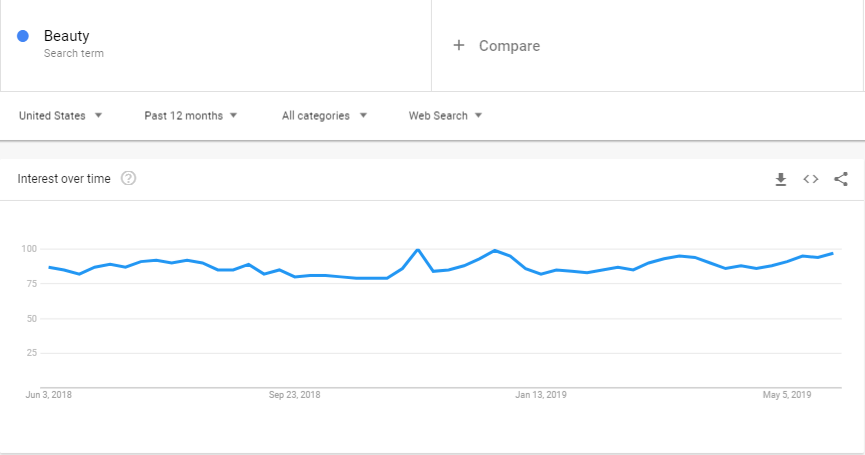
You’ll notice that the trend of the search term “beauty” is still going up, which means it gets searched a lot. This means that this search term has the potential of bringing you a lot of traffic.
Just to get you started brainstorming, here are some popular topics for blogging:
- Marketing
- Pets
- Fishing
- Travel
- Beauty
- Food
- Technology
- Health and Fitness
- Sports (check out our guide on how to start a sports blog)
- Business and Money
- Weddings
Want more help choosing a blog topic? Check out our post on the best blog niches.
Now that you have picked your topic, you’ll also want to start thinking about a good blog name.
Check out our post on how to come up with a blog name for tips.
While you’re brainstorming ideas for the name of your blog, let’s move on to the next step…
Step 2: Choose the Best Blogging Platform
Choosing the best blogging platform can be tricky. A lot of people make mistakes when it comes to choosing the right blogging platform. I’ve covered in a separate guide – how to choose the best blogging platform to help you avoid making that mistake.
Now for the question, which blogging platform should you choose when you create a blog?
The best, by far, is to start a blog using WordPress.org.
Why? Because it’s the most popular blogging platform in the world, and it’s also free.
WordPress currently powers 33.4% of the internet! That’s one-third of the internet itself.
WordPress currently holds more than 60% of the market share and is being used by brands like BBC, Wired, Time Magazine, and the New York Post.
With WordPress, you can install plugins of your choice and you can customize your website any way you want. It gives you the freedom that no other blogging platform does.
The WordPress software itself is free, but since it’s a self-hosted platform you’ll have to pay for the hosting and domain name – more on that below.
Reminder: WordPress.org is not the same as WordPress.com. To learn the differences, check out our post on WordPress.org. vs. WordPress.com.
If you’re ready to get started with WordPress.org now, you can click here and follow along in the next step:
Now that we’re done with this step, let’s move on to the next.
Step 3: Set Up Your WordPress Website
As I mentioned above, you can’t start your blog without hosting and a domain name.
What are hosting and domain names?
- Web hosting is where your website lives, like your website’s house on the internet. This is where all your website files are stored. Every website needs web hosting – without it, you won’t be able to take your blog live.
- A domain name is the address of your website. Users type it on their browsers to get to your website. For example, my domain name is www.blogtyrant.com.
For a blog host and domain name registration, I highly recommend Bluehost. Which, in our opinion, is the best hosting for WordPress.
Bluehost makes it very easy to install WordPress, so you can do it with a click of a button. No technical expertise is required!
Why Bluehost?
Bluehost is the most popular hosting company on the market. It’s recommended by WordPress and has been in the industry since 1995, making it older than Google.
Bluehost hosts millions of websites and has been working with WordPress since 2005. Users opt for Bluehost because it is more reliable and easy to set up when compared with other hosting providers.
Exclusive offer for BlogTyrant readers
We have partnered up with Bluehost to get 60% off for our readers! You also get to register a free domain for a year which normally costs around $14.99 per year.
Claim this Exclusive Bluehost offerDisclosure: If you sign up for a Bluehost hosting plan using the referral link above, we’ll get a small commission at no extra cost to you. In fact, by using our link you’ll save money and get a free domain name. This is an offer that is exclusive for Blog Tyrant readers.
How to Get Started With Bluehost
Once you click the link, you’ll be redirected to Bluehost Website. Once you are there, click on “Get started”. As shown in the screenshot below.

You’ll then be taken to a page where you have to pick a pricing plan. Select the one that suits you best.
Then you’ll be asked to “create a new domain” or “use a domain you own”
Note: make sure that you pick a unique domain name that is also brandable. If you are having a hard time deciding on which domain name to choose, you can use our domain name generator to get ideas.
If you want to wait and think about it, then you can click on “Choose free domain later.” (Before you choose your name – it’s a good idea to check the name for existing trademarks!)
Next, you’ll have to enter your account information and select the account plan. If you want the best value, then select the 36-month price.
Note: You can also purchase extra add-ons for your new WordPress blog if you like, but that’s entirely up to you. Since you’re just starting out, add-ons aren’t really important and you can skip them for now.
After you’re done, you’ll get an email with your login details to your web hosting control panel. Once you have logged in to your Bluehost account, you can find your WordPress site under the “My Sites” tab.
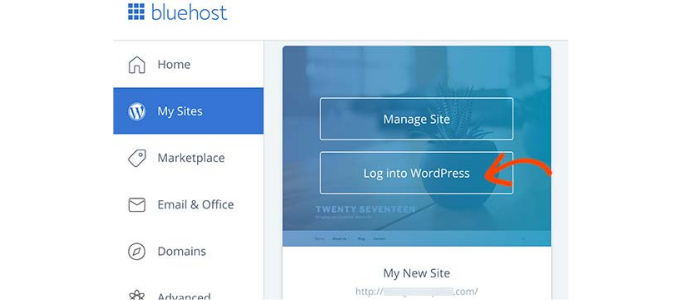
Click on Log into WordPress and then enter your credentials. Once logged in, click on Create Sites.
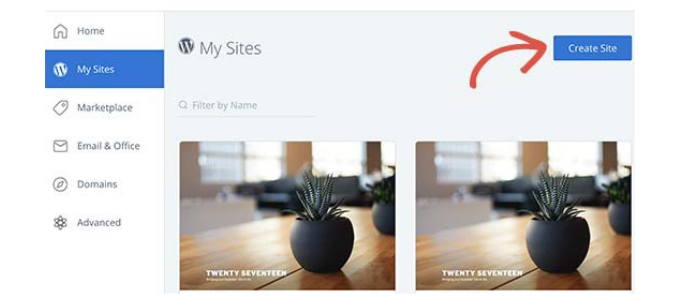
This will launch Bluehost’s WordPress installation wizard, where you’ll be asked to enter a site name and a tagline (optional).
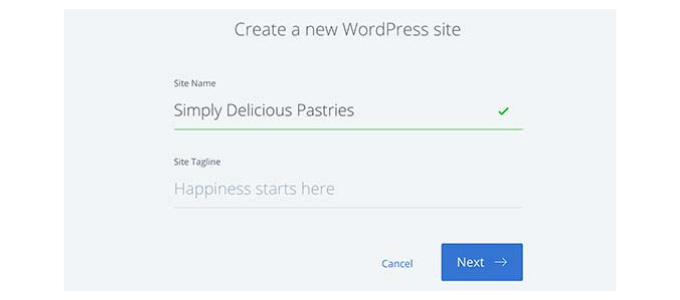
After you click on the Next button to continue, you’ll be asked to choose your own domain name from the drop-down menu. If you haven’t purchased a domain yet, you can go to the Domains tab from the hosting dashboard.
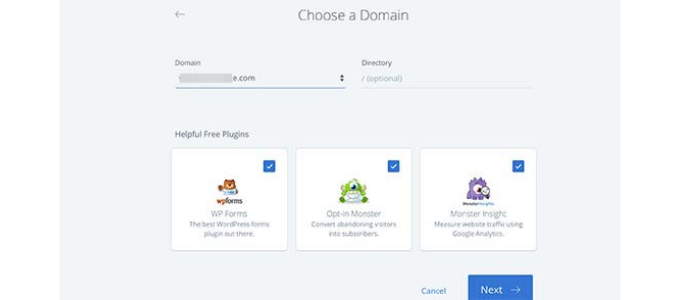
After you have selected the domain, leave the directory blank and let Bluehost choose it for you. The installer will also show you some essential plugins to install. You can add those to the installation process.
Then click on the Next button to continue. This will start the installation, and it will take a few minutes to install. After it’s done, you’ll see the success message with your website’s details.
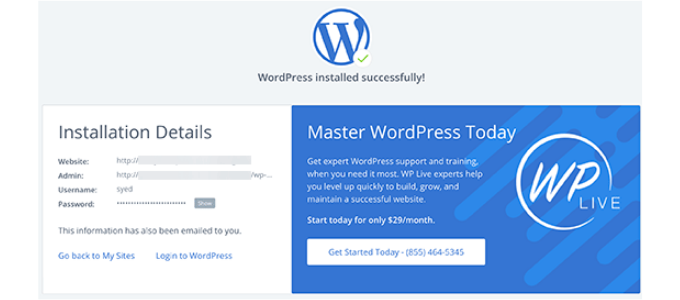
You’ll also get an email confirmation. You can click on the link that will take you to the WordPress admin area.
And that is it, you have successfully installed WordPress on Bluehost and launched your blog!
Now you can access your blog at the domain you chose (like www.example.com). To log in to the dashboard of your WordPress site and start customizing it, you can just add /login/ or /admin/ to the end of your site URL.
For example:
www.example.com/admin
www.example.com/login
For more info, see this guide to finding your WordPress login link.
You’ll notice that your blog looks very basic right now. That’s because you haven’t installed a theme or plugins to make it look better – yet.
We’ll do all that in the next step.
If you want other options for WordPress hosting providers, then check out our recommendations below. But be warned, installing WordPress on those hosting won’t be as easy as it is with Bluehost.
WordPress Hosting Providers
| Web Hosting | Cost | Rating | CTA Text |
|---|---|---|---|
| 1. Bluehost | $2.75/month | Exclusive Discount | |
| 2. HostGator | $3.78/month | Get it Now! | |
| 3. SiteGround | $3.95/month | Get it Now! |
Step 4: Customize The Design of Your Blog
Now that you have successfully taken your blog live, it’s time to start to design your blog.
After the installation, you must have noticed that your blog design looks very basic. You’ll have to install a blog theme to make it more visually appealing.
There are thousands of themes to choose from. You can either go for free themes or you can get premium themes with more advanced features.
When you are deciding on which theme to pick, make sure that you go for simplicity. It really helps when you have a clean design along with good blog content. If your blog doesn’t look good, then your readers won’t bother reading your content, no matter how good it is. You read our guide on how to choose a WordPress theme for more tips.
A couple of our favorite WordPress themes are Astra and OceanWP. They’re both free to start with, and you can upgrade to unlock even more features when your blog starts growing.

To install a theme, you need to go through the following steps from your WordPress dashboard:
- Log in to your WordPress dashboard (remember this is at www.example.com/login – just change example.com to your domain).
- On the left pane, click on Appearance » Themes.
- Click on the Add new button.
- You’ll be taken to a page where Themes are listed.
- Hover your mouse over the one you like and click on Install.
- After it has been installed, click on the Activate button.
That’s it!
For more detailed instructions, you can see this beginner’s guide to installing WordPress themes or watch this video:
You can also see this roundup of the best WordPress themes for more options.
Step 5: Install Essential WordPress Plugins
Plugins are what make WordPress powerful. Plugins can get your site to perform effectively and efficiently. You can get the best features available out there if you pick the right plugins.
With the help of plugins, you can get any type of feature or function you want on your website.
There are over 54,000 WordPress plugins available in the market for you to choose from. They can help you with creating contact forms, generating leads, growing your traffic, and so much more.
In this section, we’re going to pick out the best WordPress plugins for you, and I’ll also teach you how to install them.
How to Install a Plugin on WordPress
From your WordPress dashboard, you can install a plugin by following these steps:
- Click on Plugins on your WordPress left-hand menu.
- Search for your desired plugin.
- Click on the Install button next to the plugin you want.
- After it installs, the button will say Activate. Click on Activate to start using your new plugin.
For a more detailed walkthrough, here’s a beginner’s guide to installing plugins.
Now that you know how to install plugins, let’s talk about the essential plugins that you need to turn your blog into a powerhouse.
Must-Have WordPress Plugins
1. All in One SEO

Why is it important? It helps you optimize your blog for search engines.
Why do you need it? All in One SEO (AIOSEO) helps you to optimize your site for Google, which helps you to boost your search engine rankings and grow your blog traffic.
Even if you don’t know much about search engine optimization (SEO), you can still optimize the page by following the plugin’s recommendations.
How much does it cost? All in One SEO is free to use. However, they also have a premium version which you can use with even more features to grow your traffic.
2. Google Analytics for WordPress – MonsterInsights
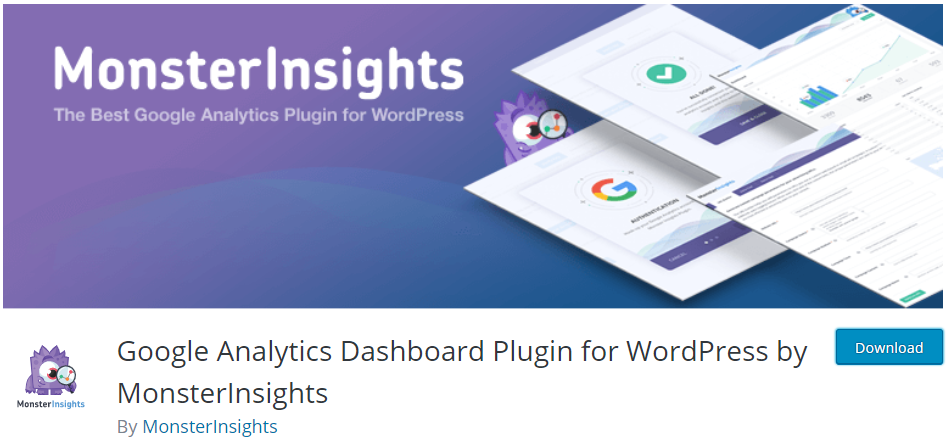
Why is it important? It helps you configure Google Analytics on your WordPress site.
Why do you need it? MonsterInsights gives you a detailed traffic analysis of your website, which helps in measuring the performance of your blog. With analytics, you can figure out what content works best on your blog and give your audience what they’re looking for.
With the help of MonsterInsights, implementing Google Analytics on your WordPress site has gotten easier. Read how to set up Google Analytics on WordPress for more details.
How much does it cost? You can get started with MonsterInsights for free or get the premium version for more advanced features.
3. WPForms
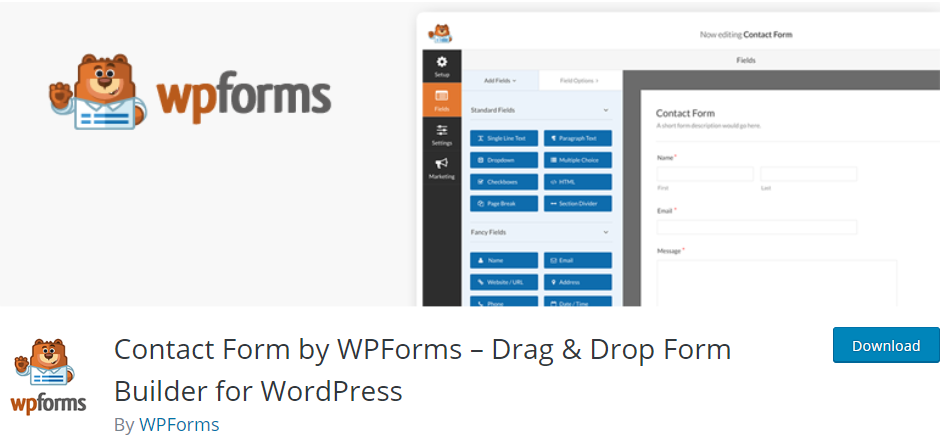
Why is it important? WPForms helps you create a contact form, which helps your readers to get in touch with you. You’ll need this, as WordPress doesn’t come with a default contact form.
Why do you need it? As a successful blogger, you should always try to engage with your readers. A simple contact form will help your readers get in touch with you without having to expose your email to spammers.
How much does it cost? It’s free, though you can get more features if you get the premium version.
4. Sucuri
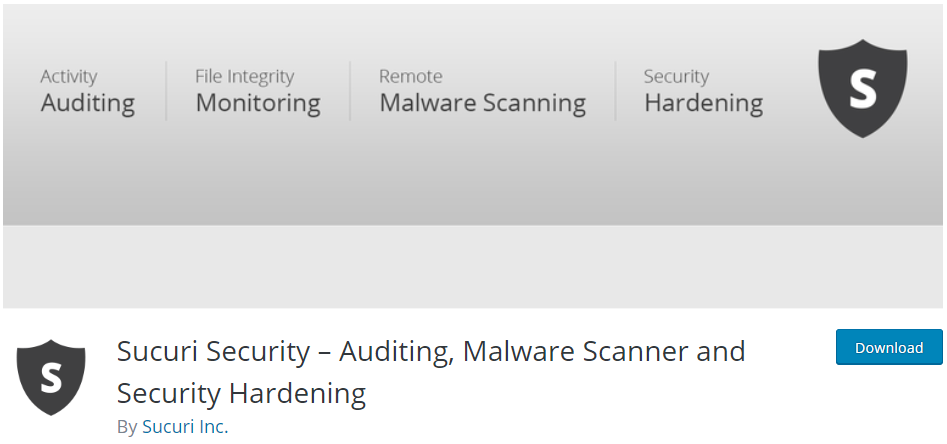
Why is it important? Sucuri helps you beef up your Site’s security.
Why do you need it? It helps hackers stay away from your website. It scans your website regularly for any vulnerabilities and notifies you in case of any breach.
How much does it cost? It’s free to use.
5. UpdraftPlus
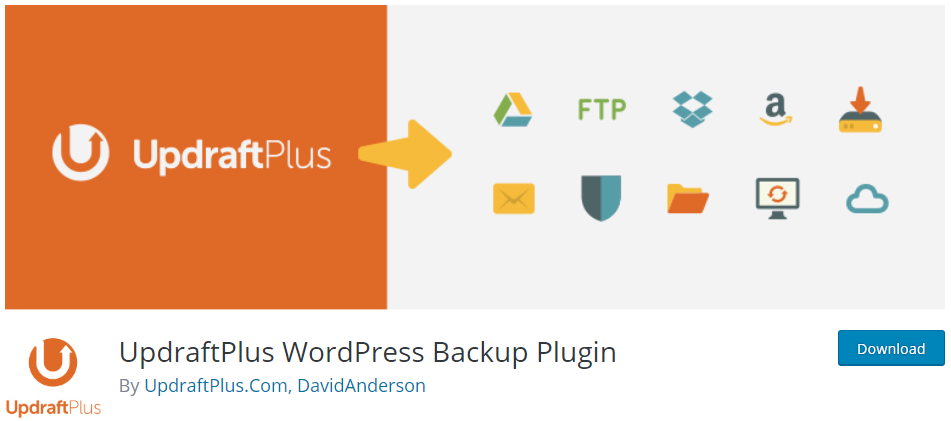
Why is it important? UpdraftPlus will create regular backups of your website in case anything goes wrong.
Why do you need it? Apart from getting hacked or being hit by malicious software, you are also vulnerable to losing all of your data. This can happen for many reasons, which is why you need to take regular backups of your data. UpdraftPlus can easily do all this by scheduling regular backups. This makes it an essential plugin to have installed on your site.
What does it cost? It’s free.
6. WP Super Cache
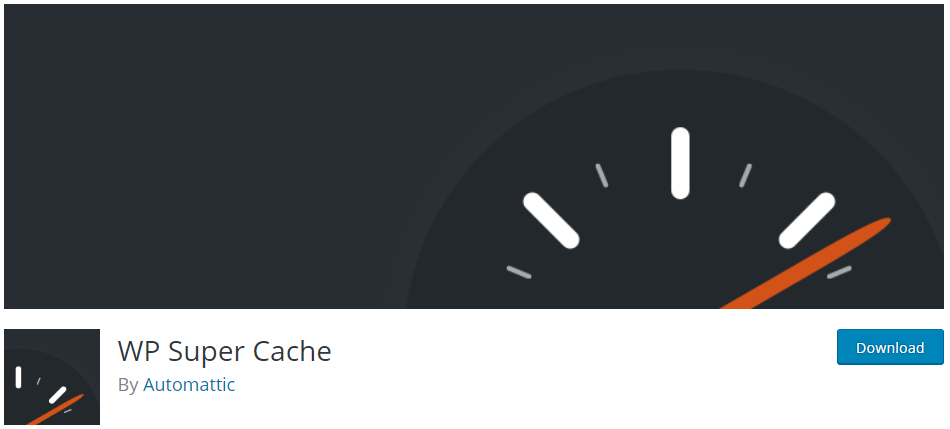
Why is it important? WP Super Cache speeds up your blog by making it load faster for your readers.
Why do you need it? No one likes to land on a blog that takes forever to load. That is an excellent way to drive your readers away. WP Super Cache optimizes your blog so that it loads faster and makes the overall experience smoother.
What does it cost? It’s free, but they do have a premium version that has more options.
Looking for more WordPress plugins to add features to your site? Check out our roundup of the best WordPress plugins.
Now that we’ve installed these must-have plugins, we’re one more step closer to our goal of creating an awesome blog.
Step 6: Configure Your Basic Blog Settings
Before you start writing, it’s important to make sure all your blog settings are configured properly.
Set the Permalink Structure
When you first start a WordPress blog, your links will look like this by default:
http://www.example.com/?p=233
So, it’s important to change your permalink settings for two main reasons:
- It makes it easier for Google to understand the intent of the blog by crawling the URL.
- It makes it reader-friendly.
Then your links will look more like this:
http://www.example.com/start-a-wordpress-blog/
To change the permalink structure, go to your WordPress dashboard, then click on Settings, and then on Permalinks.
Then all you have to do is choose Post Name, which is the best option from Google’s and the reader’s point of view.
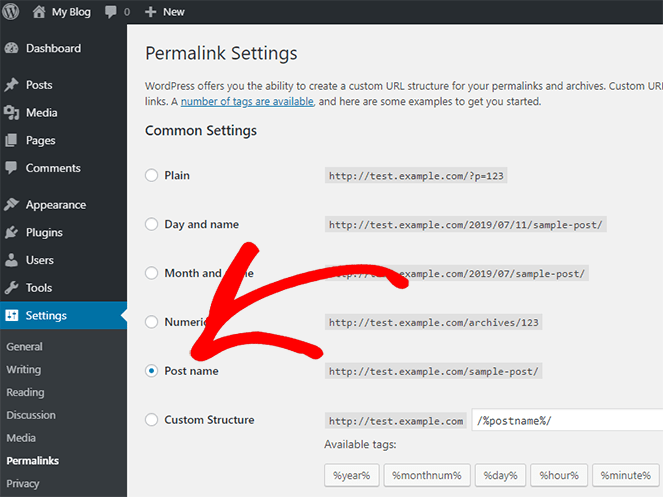
Make Sure Your Blog Is Public
This part is important if you want to get any traffic! You need to make sure that your blog is visible to the search engines so that it can be ranked. To make sure that it’s visible, you need to do the following.
- Go to Settings » Reading
- Make sure that the box in the search engine visibility section is unchecked.
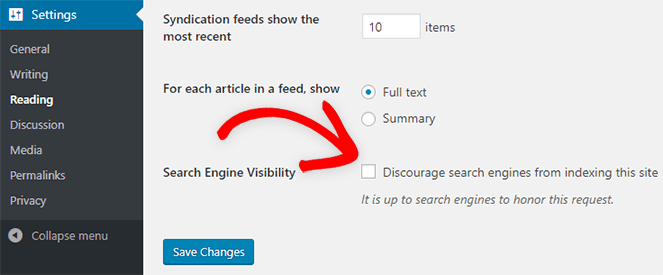
Disable Pingbacks
Pingbacks notify you when other bloggers link to you. This isn’t as helpful as it sounds. In fact, it opens your doors to spammers who will make your blog look unprofessional. It’s best to disable them and here is how you do it.
- Go to Setting » Discussions.
- Uncheck “Allow link notifications from other blogs.”
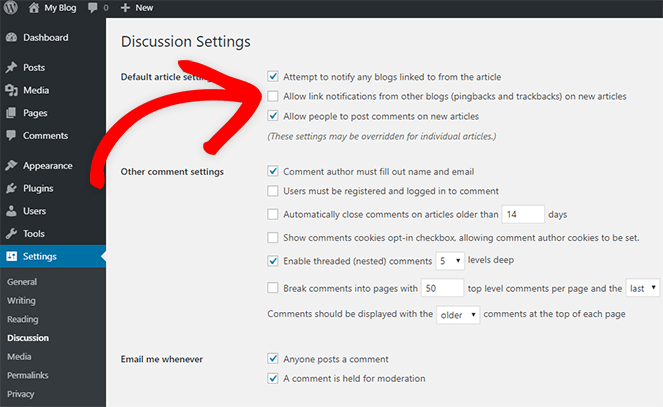
Now that you have these settings in place, it’s time to move on to the next step, create your core pages.
Step 7: Create Your Core Pages and Main Menu
Next, I’ll list some of the most essential pages you need to have when you get your blog online, along with our recommendations on how to start building them.
When you set up your blog on WordPress, there are two different types of content: posts and pages. If you’re wondering what’s the difference between a blog page and a post, check out this detailed guide to posts vs. pages in WordPress.
When first starting a blog, you’ll need to create these pages:
- About Page
- Contact Page
How to Create a Page in WordPress
To add a new page in WordPress, just click on Pages » Add New.
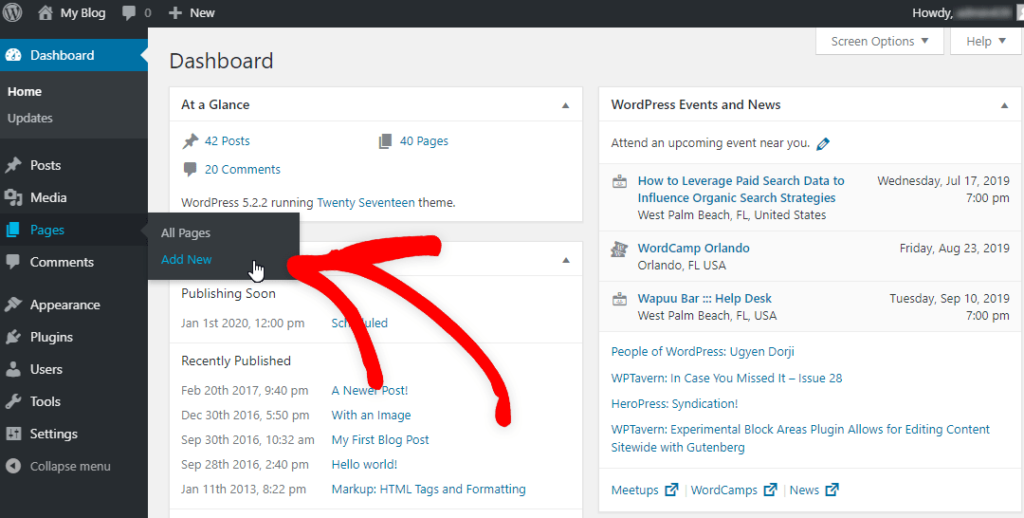
From here, you can add your page title and your content in the text editor. Check out these WordPress content editor tips for more details.
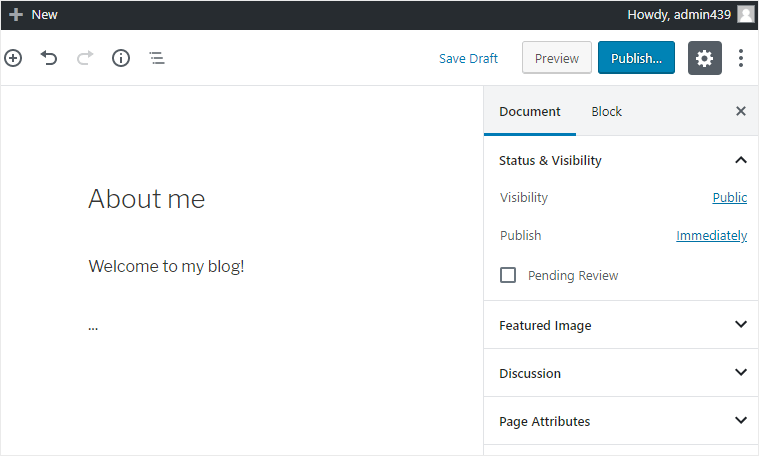
When you’re done, just click the Publish button and it will be live on your site.
Let’s take a look at how to create these pages and what they should include.
1. About Page
On your “About” page, you should introduce yourself to your readers and talk about what they can expect from your blog. Link out to your other social profiles so that your readers can stay in touch with you.
2. Contact Page
A contact page is essential if you want your readers to get in touch with you. You can create a contact form in less than 5 minutes with WPForms. All you need to do is add some instructions, and the plugin will take care of the rest.
These pages should be enough to get you started!
If you want to create custom pages for your blog, I recommend using a drag-and-drop page builder like SeedProd. It offers 100+ templates for email opt-in pages, sales pages, coming soon pages, and much more to help you get more email subscribers or any other conversions you wish.
All of the templates are easy to customize; simply drag pre-made blocks like headings, buttons, images, videos, contact forms, etc., and drop them onto your page.
Creating Your Main Menu
Now that your pages have been created, it’s time to add them to the main menu of your new blog.
To create a menu in WordPress, click on Appearance » Menus. Enter a name for your menu (I just named mine “Main Menu”) and click Create Menu.
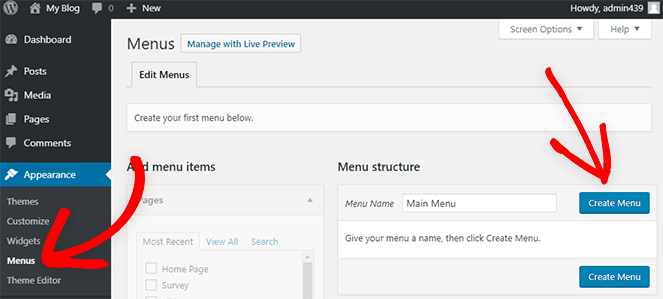
Now you can add your new pages to the menu. On the left side, under Pages, check the box next to the pages you want to add to your menu. Then click Save Menu.
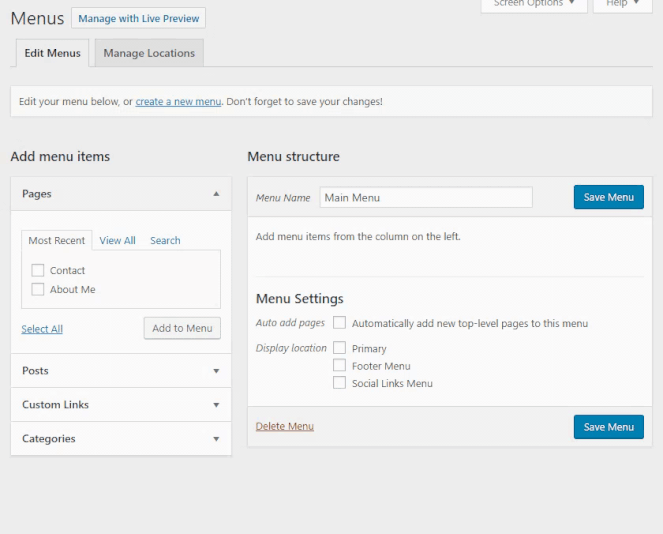
To add the menu to your header, click on the Manage Locations tab at the top. Then select your menu in the location where you want it to appear. Note that your menu locations will be different depending on your theme, but usually, there’s a primary, main, or header menu area for you to add your main menu.
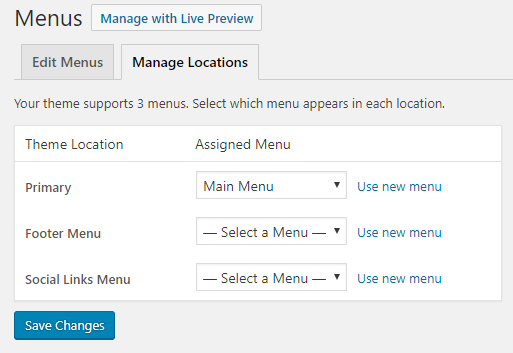
Congrats! You’ve finally created your own blog… but what good is a blog if you don’t know how to come up with great content ideas and promote them to make money online?
I’ll discuss how to create content in our final three steps. Keep reading.
Step 8: Generate Content Ideas and Write Your First Post
Alright, ready to get started with blogging?
The first thing you should decide is how often you’ll write and publish a new blog post. The best way to go about it is to make a content calendar. Decide on which days you’ll post your blog, and then stick to it.
I recommend starting with one blog post per week. This will give you plenty of time to learn the ins and outs of how to write blog posts.
As a blogger, you’ll need to be as disciplined as possible about running a blog. If you’re serious about scaling your blog into a full-time business, then make sure that you don’t miss the deadlines you set for yourself.
Now that we have got that out of the way let’s talk about how to generate content ideas!
How to Generate Blog Post Ideas
In order to come up with high-quality content ideas, you need to be listening to your audience. You should know their problems and then try to come up with solutions that help them.
But when you’re first getting started with a blog, you don’t have an audience yet! So how do you know what they want to read?
There are two ways how you can find what your readers want to read.
- Analyzing your competition
- Research the communities where your readers are most active.
Analyzing Your Competition
You can gain a lot of ideas if you go through other websites in your niche or industry and see what they blog about.
In step 1 above, I talked about researching other blog posts to pick a niche for your blog. You can revisit those same sites to get ideas for new content so that every blog post appeals to your readers.
Just make sure to put your own spin on the topic and not copy the content itself. Your blog posts should be 100% original. Think about how you can improve on your competitor’s posts and create something even better to create a successful blog.
Researching the Communities Where Your Readers Are Most Active
There are a lot of communities and forums on the internet that can help you get more ideas. Our favorites are Reddit and Quora.
People ask a lot of questions on Quora about different things. You can search your topic in the address bar and you’ll get a list of all the related questions on your topic. Go through these questions and their answers. Compile the data you have gathered and write something that provides an answer.
Start following related topics on Quora so that you get notified whenever the community asks a question related to your topic.
Follow the same process for Reddit; you’ll be surprised by the number of ideas you get from these communities.
For more ideas, see our giant list of blog post ideas you can steal and our guide to types of blog posts that work for any niche.
Now that you know how to get content ideas, it is time to get to work. Add them to your content calendar and set a deadline for each topic.
Step 9: Grow Your Blog Traffic
When you’re first starting your blog, it can be tough to build your audience. How do you let the world know about your new blog and start growing your traffic?
My favorite method is using search engine optimization (SEO) on your blog and get more visitors to your site.
SEO is the strategy of increasing your visibility on search engines like Google. This way, when people search for topics you write about on your blog, your blog posts will rank on the first page, and you can attract lots of readers.
Next, I’ll share some basic SEO tips to help you get started.
There are two aspects of SEO:
- On-Page Optimization
- Off-Page Optimization
Let’s take a look at how you can use these tactics to grow your blog traffic.
On-Page Optimization
On-Page optimization means the optimization and the tweaks you do on your website. On-page optimization includes the following:
- Speeding up your WordPress website
- Keyword research – discovering the phrases people are using to search for your blog topics
- Optimizing your title and blog post to use your keywords the right way.
I know that this sounds like a lot of work, but it’s not hard to get started with the basics! You can read our beginner’s guide to SEO for bloggers to learn more.
To get you started, I’ll only focus on keyword research in this guide and teach you how to use the keywords you found in the right places.
You can use Google Keyword Planner to do your keyword research for free. You can either insert the URL of your competitor’s blog post or you can enter your topic idea to get a list of keywords. Pick the ones that have a high volume. This will increase your chances of getting more traffic.
You can also try searching for the topic of specific blog posts in Google and look at the suggested searches at the bottom of the page for keyword ideas.
Once you have your list of keywords, use the keywords in the following places:
- Blog post title
- URL of the page (called the permalink)
- H1 (The main heading)
- H2, H3 (The sub-headings)
- Image alt text
- Meta description
- In the blog post itself
If you have All in One SEO installed on your site, it will make your life a lot easier. All in One SEO (AIOSEO) will keep on reminding you about the placement of your keywords and even recommend areas of improvement. The plugin grades your content on the basis of Basic SEO and Readability. Follow the suggestions to get a good SEO score like in the screenshot below.
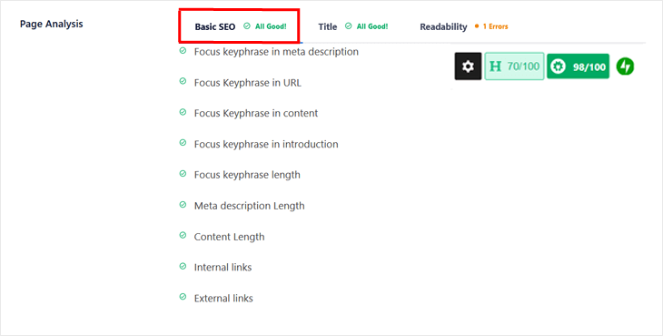
Find out more about this plugin by reading our All in One SEO review.
Off-Page Optimization
Off-page optimization is when you build links or reach out to influencers to promote your blog.
Link building can be tricky, especially if you are doing it for the first time. To get you started, I’ll share some basic tips here.
First, it’s best if you join communities where your audience is located. Start participating in threads and add value to them. It is highly advisable that you shouldn’t put your links in as soon as you join the community. Instead, you should get to know the users and find ways to sympathize with them and only link to your website where it’s relevant.
Another easy method is to find fellow bloggers or influencers on Twitter. Start interacting with influencers and share their tweets and content. The goal here is to get on their radar and build a relationship so that they might be interested in accepting guest posting. Once you have their attention you should introduce yourself and your blog and see if they would share your blog content with their audience.
Ahrefs Content Explorer and BuzzSumo are our favorite tools for finding influencers online.
SEO is an in-depth topic, and to say that I’ve covered everything in this small section would be a lie. So, be sure to read this in-depth SEO guide for bloggers for more information.
Step 10: How to Make Money Blogging
Congrats, you’re blogging now!
The next question that pops up in every blogger’s mind right after they launch their blog is, “How do I make money by blogging?”.
Again, there are many ways you can monetize your blog. I have even compiled a guide on various ways to make money online.
If you want your blog to make money, I’ll talk next about some of my favorite methods to monetize my blogs.
1. Google Adsense
Google Adsense has been around for a long time, and bloggers have been leveraging its services to make money. Google Adsense is an advertising platform for bloggers and publishers. Once you have Adsense enabled on your blog, your readers will start seeing ads on your blog. You get paid to show these ads, and you get paid more when a visitor clicks on them.
Learn more about how to add Google Adsense to your blog.
2. Affiliate Marketing
Another way to monetize a blog is through affiliate marketing. Bloggers can make money promoting other people’s products and getting paid whenever a referral buys their product or service.
Affiliate marketing is easy to get started with all you have to do is sign up for the affiliate programs of the product that you are using or would generally use.
They will give you your affiliate link, which you can place on your blog. Every time a visitor clicks on that link, they will be taken to the product’s website that you are promoting, and you will start making money. You’ll get a commission if your referral makes a purchase. This is a great way to generate passive income because you can make money repeatedly from the same link.
And tons of products and platforms online offer affiliate partnerships. To sign up and get started, check out the best affiliate marketing programs and networks!
And you’ll also want to use a link management tool like PrettyLinks to cloak and shorten the URLs on your WordPress blog.
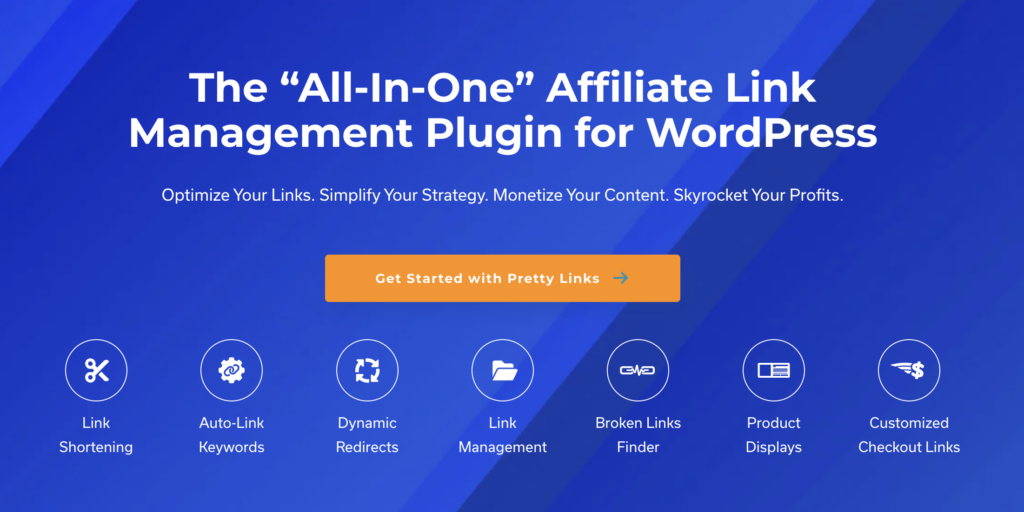
You can also check to see if the product you are using offers affiliate partnerships. For example, I’m a huge fan of Constant Contact, and I regularly promote them because they are just that good.
You can do the same!
See our beginner’s guide to affiliate marketing to get started.
3. Create an Online Store
Building a profitable blog is a great way to make a lot of money by selling things. All you need is an eCommerce plugin, and when it comes to WordPress eCommerce plugins, there is none better than WooCommerce.
To get started, follow our guide on how to create an online store.
If you find maintaining inventories and managing shipments a hassle, then I’d suggest that you look up drop shipping. It’s an awesome, hassle-free way to start selling online.
Launching your blog is just the tip of the iceberg. Now you’ve set up your own blog, you still need to practice and keep learning in order to drive traffic to your blog and become a great blogger.
Make sure you check back regularly for more blogging guides and tips. You can sign up for our email newsletter to stay informed.
Before I wrap up, I’d like to share a cheat sheet of my favorite blogging tools to help you reach the next level.
Popular Blogging Tools
Here are some tools to help you along the way on your blogging journey.
Analytics and SEO Tools
- Google Analytics – Google Analytics gives you insights into your traffic and visitor behavior so you can grow your blog. You can easily set up Google Analytics with MonsterInsights.
- Google Search Console – This tool helps you understand how Google treats your site in search results. It also reports any errors that may require your attention.
- IsItWP Website Speed Test Tool – See how quickly your website loads and what you can do to speed it up.
For more, see our roundup of the best SEO tools for bloggers.
Tools for Blog Promotion
- BuzzSumo – Find influencers in your niche and find popular topic ideas.
- Constant Contact or Sendinblue – Start sending a regular email newsletter to your audience to market your blog.
- OptinMonster – Create popups and other campaigns to grow your email list.
- Buffer – Schedule your posts on social media to get more blog traffic.
See our list of the best marketing automation tools to keep growing your blog.
Tools for Writing and Design
- Grammarly – Fix any grammatical mistakes you might have made.
- Canva – Create and edit beautiful images for your blog.
- Unsplash – Download free stock images.
Guides for Further Reading
Ready to take your blog to the next level? Here are our best guides on blogging.
Blogging Tips:
- 16 of the Most Brilliant Tactics in Blogging History
- An 8-Step Formula for Blogging Success
- Will Your Blog Ever Be Profitable Enough to Support Your Family?
- 101 Blogging Tips
- How to Get Google to Send You 119,717 Visitors Every Month
- 21 critical tasks to perform after you have launched your blog
SEO Guides:
- SEO for Idiots: The 10 Basics of Blogging Search Engine Optimization
- How to Get More Backlinks and Rank Higher on Google
- 6 SEO Secrets Every Blogger Needs to PWN Today’s Google
Making Money with Blogging Guides:
- How to Make Money Blogging: A Realistic Guide for New Bloggers
- 7 Simple Ways to Make More Affiliate Income from Your Blog
- Why You Might Want to Reconsider Using Ads on Your Blog
- Blue-Shirt Trust: How to Increase Conversions on Everything
How to Start a Blog – FAQs
Can I build a blog without hosting?
No, you can’t. All professional blogs need good web hosting. I have always recommended Bluehost because I love it and use it myself.
However, if you want more options, you can check out our best web hosting for WordPress guide.
How do I compete in a competitive niche?
By being different and by being consistent. It doesn’t matter how competitive the niche is, if you are adding value, then you’ll succeed.
Analyze your competition, what kind of content they cover, how good their design is, how often they post, and do they have a social presence. Take all of that and create something better.
Also, analyze the type of links they are getting and from where they are getting from.
Follow the 10x approach and make something better and then reach out to the people who are linking to your competitor. Chances are that they will replace their links with yours if you truly have something better to offer.
How do I get readers to read my blog?
By writing on topics that your readers want to read. In order to find what interests your reader, you’ll need to be active on the forums where your readers hang out the most. Observe what they talk about and the kind of questions they ask. Then come up with a solution and write a blog post on it. Writing for your target audience will always bring in more readers.
What type of blogs make money?
There are many niches in which bloggers make a lot of money. You need to do your research on profitable niches and work on a niche that has an upward trend. Some of the popular niches to make money as a blogger are:
- Personal Finance
- Fishing
- Travel blogs
- Health and Fitness
- Beauty and Fashion
- Lifestyle
Final Thoughts on How to Start a Blog
That’s it! You’re finally done creating your blog from scratch. I’ve tried to keep this guide on how to start your blogging journey as simple as possible, but if you find anything confusing, don’t hesitate to reach out. I’ll be happy to guide you to the best of my abilities.
For now, go and enjoy your blog, tweak and tinker with it, and see what works for you the most!
And thank you for taking the time to read our guide. I’d love to get your feedback in the comments below.
Happy blogging!

